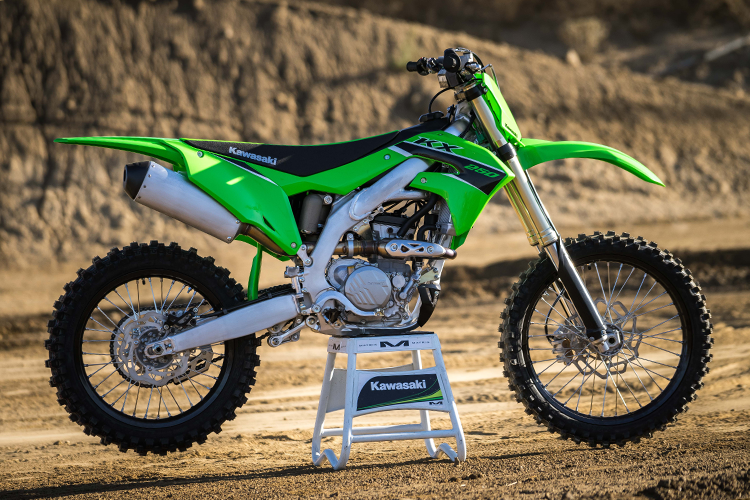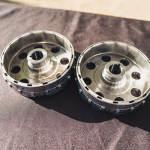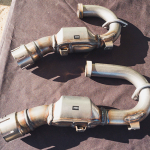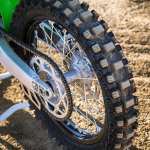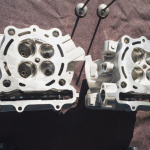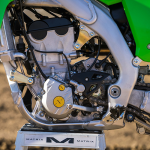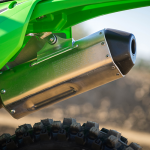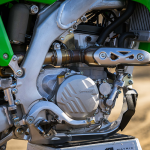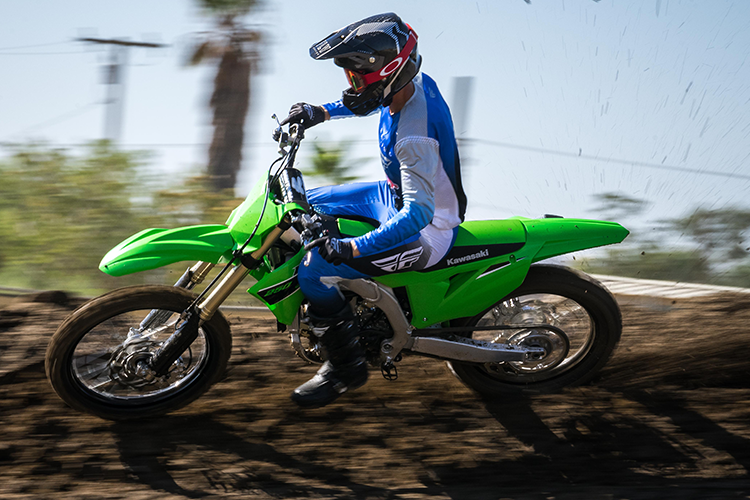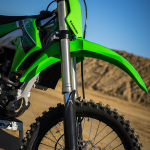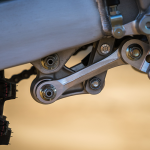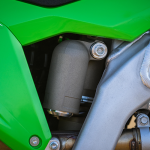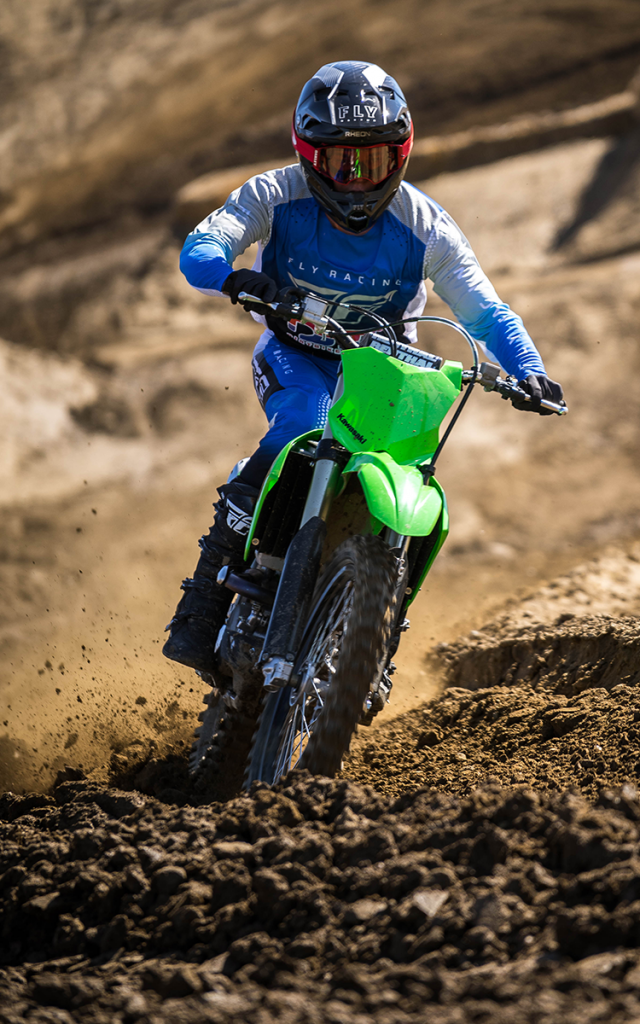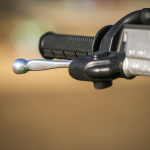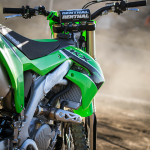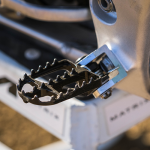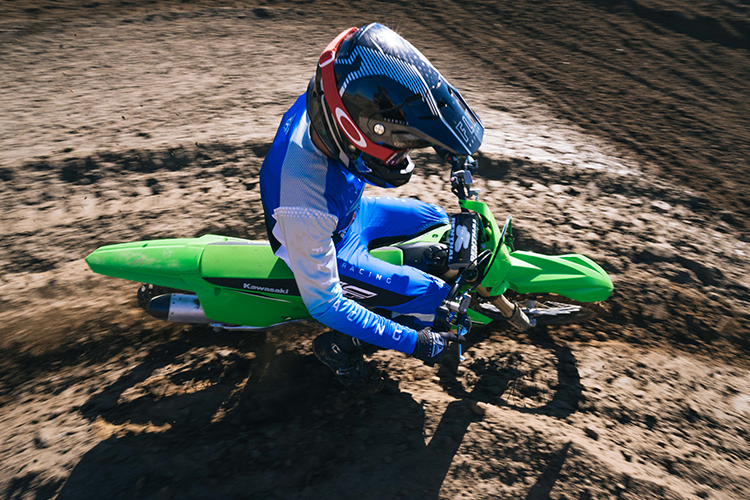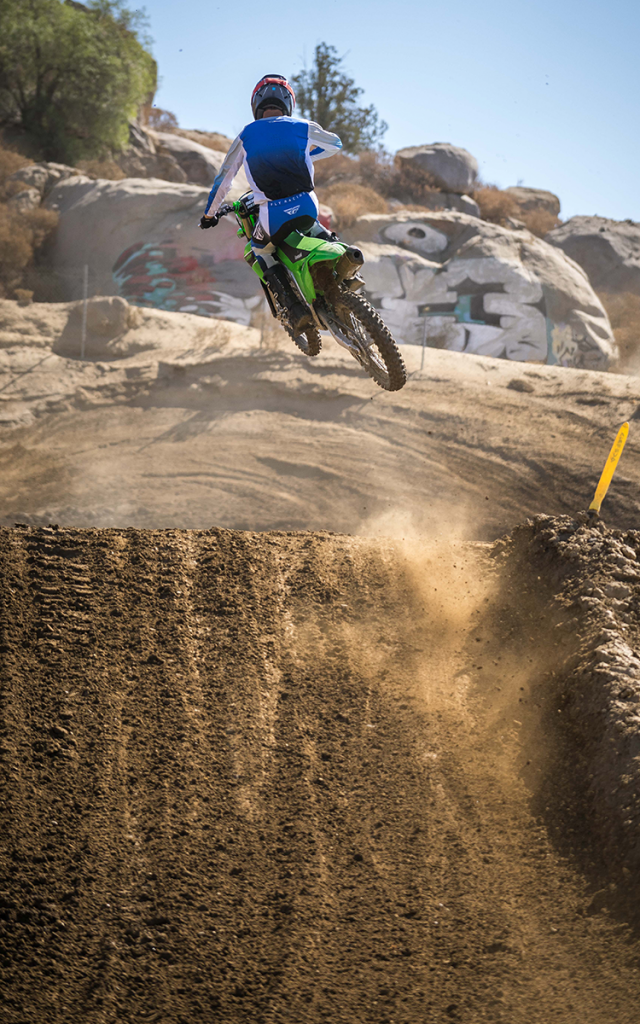2023 KX250 First Impression
Story by Trevor Hunter, Photos by Trevor Hunter, Octopi Media
We just wrapped up a day of riding Kawasaki’s newly revised 2023 KX250 at Perris Raceway. While most of the changes would be tough to spot to the naked eye, the men in green made a handful of big changes to the engine, as well as some chassis refinements, for the new model year. We had a couple of off-road Pros spin laps from early morning until the track shut down to get the most out of this bike in a single day. Both have previous experience on Kawasaki’s KX250X model, and liked the last two years of this machine.
The 250cc four-stroke engine sees a host of new updates including “a 1.5mm narrower pitch for the intake valves and increased clearance at the valve seats” which are claimed to increase efficiency and improve combustion. For reliability purposes, the intake valves are now 1mm smaller to go along with the narrower pitch. An updated bridged-box piston with a dry film lubricant on the piston skirts is designed around the new head and valves, to increase lower RPM performance. As described by Mitch Payton, the smaller valves allow for a better airflow down into the cylinder as they don’t sit right up against the cylinder wall.
A redesigned airbox and boot features a straighter, tapered intake with the second fuel injector moved to the bottom of the boot (from the top) for a “downstream” flow. These changes are aimed at improving the already impressive high RPM performance of the KX250 engine. Other notable engine performance changes include updated mapping, a 100mm longer header for better low-mid range power, a heavier flywheel, and some hydraulic clutch component updates. The transmission ratios are altered with a longer first gear and longer second gear to accomodate.
Suspension updates include new settings front and rear, with an aim to help cornering performance, something that KX didn’t always excel in. The rear linkage collar has changed from steel to aluminum and hollow bolts hold everything together for weight savings out back.
Some of the smaller, but still significant, changes to the 250cc models include MX33 tires with a 110-90-19 now mounted, new footpegs that are now shared with the KX450 and mounts that are now 3mm back, and of course bold new graphics. Retail price is $8,499 for the KX250 and $8,599 for the KX250X and are available in dealers now.
Power
The power on this KX is impressive. Since it’s major overhaul in 2021, the 250cc four-stroke powerplant has put out some serious power in the mid-top end. Aggressive riders who like to rev, or lazy riders who don’t like to shift, appreciate this kind of power and for 2023, it has improved. Starting down low, there is more usable power and torque, enough to where it doesn’t fall on its face if in the wrong gear or a mistake is made mid-corner. Carrying through to the mid, it revs quickly and easily, continuously building power as it climbs into the top end where it’s still one of the best in class. The KX motor is one that needs to be revved to really get the most out of it, but it also likes to be revved. We found it easy to be ridden in its “sweet spot” of the powerband, even when our riders aren’t necessarily ones who naturally rev bikes.
The new transmission ratios felt good on track today. 2nd gear seemingly pulled forever as you could corner and hit most jumps without the need to shift. The longer 2nd gear paired with an engine that likes high RPMs saw us riding in 2nd gear a lot. Equally, the jump to 3rd gear was seamless for our 160-170lb testers today and we didn’t find ourselves between gears in any section of the track.
We switched between the different couplers and all worked well in different ways. The stock (Green) coupler is a good all-around map that does everything you need it to do. The mellow (Black) coupler smoothed the power out and had good bottom end, but sacrificed overall for our faster riders. The aggressive (White) coupler was snappy, exciting, . Typically, we’ve come to like the “Mellow” coupler in years past as it helped the bottom end on the KX, a place where it lacked in comparison to some other 250F’s. Today, we had different feelings. The “aggressive” coupler was exciting, revved out for days, and made the already impressive top-end that much more impressive. Down low had a good punch, but when you can be aggressive with the throttle and you like to rev the bike out, this was a good map to use. Although we settled on the aggressive coupler today, you can’t go wrong with the stock coupler as it works well everywhere. While we wish we could change mapping on the fly, it’s good to know these couplers do make a difference.
The engagement point in the Nissin hydraulic clutch is broad and the clutch pull is smooth. Most of our testers who are more accustomed to a cable-pull clutch prefer the Nissin system as it has more feel and modulation than that of the Austrian brands — more of a rider preference than anything though.
Suspension
Kawasaki has stuck with the same KYB coil-spring components front and rear for 2023 with just refinements in valving for the new model year. We haven’t spent much time in the KX250 moto models, mainly the X off-road models, but the suspension worked as expected. It’s firm, holds up to bigger jumps, yet still offers comfort to the rider. Perris is a hard-pack track and with minimal riders and dry conditions, there weren’t many bumps to truly put the KX suspenders to the test today. However, with the few bumps and jumps that were on the track, we felt the suspension worked quite well. It boasts good bottoming resistance and hold up for bigger jumps and braking bumps, but still soaks up the small chatter and choppy ruts. For our midweight riders (160-170lb range), we felt stiffening up low speed compression on the rear shock two clicks helped firm up the rear end to balance out the bike and keep it from bottoming and kicking on some bigger braking bumps. One of our testers, who likes to run a bit more sag than most, also increased sag from ~100mm to ~102-103mm to get a little more stability out of the bike on the faster sections of the track. This helped the overall balance of the bike. With 100mm, it was too front end heavy and we were having trouble with the front end knifing in sweeping corners. Part of this could be the MX33F front tire not gelling with the hard pack track conditions. A MX53F or similar tire could fix this issue, but we still feel the extra sag helped with stability and balance.
Handling
The KX feels very thin and nimble on the track with a rider-friendly cockpit. Both riders today, and on previous Kawasaki models of this generation, really enjoy the rider triangle/cockpit of the KX’s as everything feels natural as if it should be in its place. Sitting on the bike, it is very thin and is a standout feature in a good way to our testers. The overall chassis offers a lot of comfort and reacts well to conditions that can challenge an ill-handling bike. It’s not the most precise bike, but its narrowness between the legs helps offset this. You feel in total control of the machine, and it has a light feeling with help from a responsive motor that lets you jump and hop around.
The brakes work pretty good, but the thin front brake lever isn’t a crowd pleaser here at DBT. It’s uncomfortable to apply a lot of pressure to the lever and is something we haven’t liked for a couple of years now. The bike is fairly stable and corners pretty good. It isn’t the best in either category, but it does both very well.
Overall, the KX250 engine is improved in our book. Where it lacked the most, it picked up some steam and carried that through the rest of the power where we believe it is one of the best 250F motors in the class. It likes to be revved, it’s easy to rev, and it gets to those revs that much quicker with the engine updates for 2023. The suspension worked well with minimal changes for our initial day on the bike, but admittedly it wasn’t a suspension testing type of day. Which in truth, is a good test for the average rider who isn’t looking to pound endless braking bumps at Glen Helen late on a Thursday. For those who ride vet tracks and are “fair weather” riders that don’t stick around long enough for the track to get rough, we can say the suspension works quite well.
Do You Like DBT Bringing You Fresh Content? Search and Shop Through the Links Above or Below:
